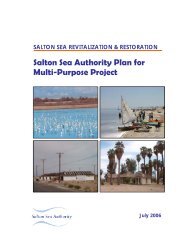Salton Sea Preliminary In-Sea Geotechnical Investigation
Salton Sea Preliminary In-Sea Geotechnical Investigation
Salton Sea Preliminary In-Sea Geotechnical Investigation
Create successful ePaper yourself
Turn your PDF publications into a flip-book with our unique Google optimized e-Paper software.
SECTIONFOURPotential Geologic And Seismic HazardsSECTION 4POTENTIAL GEOLOGIC AND SEISMIC HAZARDSThis section provides a preliminary evaluation of the potential geologic and seismic hazards that couldimpact the restoration project. The primary hazards are fault rupture, strong ground shaking, soilliquefaction, and seiches. The following paragraphs qualitatively discuss these potential hazards,additional studies will be required to quantify and further define the potential hazards.4.1 FAULTING AND SEISMIC GROUND DEFORMATIONSAn active strand of the San Andreas Fault is mapped approximately 1.8 miles east of the east end of themid-<strong>Sea</strong> location. The nearest reach of the fault has been known to undergo longtime creep and triggeredslip following nearby large earthquakes (Agnew and Wyatt, 2003). The mapped alignment of the SanAndreas Fault is somewhat parallel to the long axis of the <strong>Sea</strong> and is projected to enter, or just skirt, thesoutheast corner of the <strong>Sea</strong> east of Bombay Beach. To the west and southwest, the active strands of theSan Jacinto and Elsinore faults trend sub-parallel to the San Andreas fault at respective distances of 13.4and 35.5 miles from the west end of the mid-<strong>Sea</strong> location. Surface delineations of historically activestrands of the Imperial and Brawley faults extend to within about 15 miles of the south end of the <strong>Sea</strong>.Two bands of seismicity suggest fault zones cross the southern end of the <strong>Sea</strong> (Figure 6), one trendingsouthwest to northeast and the other an apparent extension of the onshore mapped locations of either theSan Andreas or Imperial Faults. This north-northwest trending band of seismicity is known as theBrawley Seismic Zone.Surface rupture associated with earthquake faults is a potential hazard to the restoration project. Theresults of this preliminary investigation do not preclude the possibility that an active fault could crossproposed embankment locations. This potential fault rupture hazard should be further evaluated to assessthe possible presence and activity of the faults. A program to investigate this potential hazard is discussedin Section 7.2 of this report.Long term geodetic measurements indicate vertical crustal deformations along and near most of the activefaults in the area (Gilmore, 1986). Locally, the Lake Cahuilla shorelines show evidence of verticalwarping (Norris and others, 1979) and differences in elevation up to as much as 20 feet are indicated fromnortheast to southwest across the <strong>Sea</strong> (Grunsky, 1907). The geomorphic expression of the Durmid Hills(immediately east of mid-<strong>Sea</strong> location) suggests local topographic uplift along the San Andreas Fault. Therate of vertical uplift however, as indicated from the <strong>In</strong>dio Hills, suggests the vertical slip componentalong the San Andreas Fault is relatively low, and may be only about 3 percent of the horizontal slip rate(Norris and others, 1979). Potential seismic-induced ground deformations should be further evaluated.4.2 GROUND SHAKINGThe restoration project will likely be subjected to severe ground shaking in response to either a local ormore distant large magnitude earthquakes occurring during the life of the planned project. A ProbabilisticSeismic Hazard Analysis (PSHA) should be performed in future studies to estimate the recurrence andmagnitude of ground motions that could be expected at the <strong>Sea</strong>. This analysis is a mathematical processthat combines: (1) the probabilities of an earthquake of a particular magnitude occurring on a givensource; (2) the distance of the rupture surface to the site; and (3) the attenuation of the ground motions,W:\27663042\00005-c-r.doc\1-Mar-04\SDG 4-1



